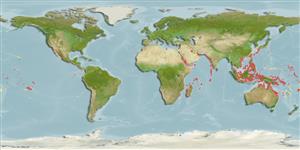Bivalvia |
Mytilida |
Mytilidae
Environment: milieu / climate zone / djupintervall / distribution range
Ekologi
. Tropical
Indo-Pacific.
Length at first maturity / Size / Weight / Age
Könsmognad: Lm ? range ? - ? cm
Found boring in dead and living corals at intertidal and subtidal zones (Ref. 85421). In Hong Kong, also reported boring into the commercial oyster Crassostrea gigas (Ref. 75840).
Life cycle and mating behavior
Könsmognad | Reproduktion | Lek | Eggs | Fecundity | Larvae
Members of the class Bivalvia are mostly gonochoric, some are protandric hermaphrodites. Life cycle: Embryos develop into free-swimming trocophore larvae, succeeded by the bivalve veliger, resembling a miniature clam.
Poppe, G.T. 2010 Philippine marine mollusks: III. Gastropoda Part 3 and Bivalvia Part 1. ConchBooks:Hackenheim. 665 pp. (Ref. 86910)
IUCN Red List Status
(Ref. 130435: Version 2025-1)
CITES status (Ref. 108899)
Not Evaluated
Not Evaluated
Threat to humans
Human uses
| FishSource |
Verktyg
Ytterligare information
Trophic EcologyFood items (preys)
Födosammansättning
Födointag
Predatorer
Population dynamicsTillväxt
Max. ages / sizes
Length-weight rel.
Length-length rel.
Length-frequencies
Mass conversion
Abundans
PhysiologySyreförbrukning
Human RelatedStamps, coins, misc.
Internet-källor
Estimates based on models
Price category
Unknown.
